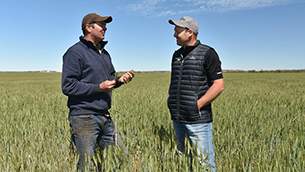Smooth start for new liquid form of popular herbicide
About
-
Category
- Grower Stories
- Product News
-
Date
29 October, 2019
-
Location
Nabawa, WA
-

About
Category
- Grower Stories
- Product News
Date
29 October, 2019
Location
Nabawa, WA
Farm Manager Austin Rayner took the opportunity to trial a new liquid version of the popular pre-emergent herbicide, Sakura®, on the EF Smart Pty Ltd property near Nabawa in the northern wheatbelt this season and it has proven a seamless transition.

Image: Bayer Commercial Sales Representative Ty Gronow and Austin Rayner, Farm Manager at the EF Smart Pty Ltd property, ‘Wicka’, near Nabawa, discuss the application of the new Sakura Flow liquid pre-emergent herbicide through the farm’s John Deere 4060 self-propelled sprayer.
Sakura, as the water dispersible granule (WG) formulation, has played a vital role on the property to help limit annual ryegrass populations and also suppress brome grass.
Austin manages a 15,100-hectare cropping program comprising wheat, canola and lupins on country ranging from strong red loams through to yellow sandplain soils at the ‘Wicka’ farm in the Chapman Valley Shire.
Sakura has traditionally been applied in paddocks that in the previous season have been worked to a depth of 30-35 centimetres with a 13-furrow mouldboard plough to help improve non-wetting soils, as well as in any “dirty’’ (weedy) paddocks.

Image: Austin and Ty inspect the good annual ryegrass control provided by Sakura in wheat on the ‘Wicka’ property
“We have generally mouldboarded and gone straight in with wheat and no chemical, and then in the second year have continued with wheat and Sakura,’’ Austin said.
“It is generally applied every second year. It seems to be one of the safest ‘pre-ems’ (pre-emergent herbicides) and has helped to keep the ryegrass numbers low.
“We have used Treflan and normal knockdown (herbicides) with Sakura and we also use Boxer Gold® in the rotation, but we find other pre-emergents can hot-up crops in the early years after mouldboarding.’’
He said Sakura had definitely helped to “clean-up’’ paddocks and had performed well even in high trash years.
The Group K herbicide is incorporated during sowing with Ausplow DBS rigs set on 30-centimetre tyne spacings.
The new Sakura Flow suspension concentrate (SC) formulation now available is applied at the low rate of 210 mL/ha for up to 12 weeks residual control of annual ryegrass, barley grass, annual phalaris, silver grass and toad rush in wheat (except durum wheat), triticale, chickpeas, field peas, lentils and lupins, as well as for suppression of brome grass and wild oats.

Image: Austin and Ty consider how wheat crops are “hanging-on’’ well at the ‘Wicka’ property despite the below average rainfall and tight finish to the season.
The convenient liquid option, offering the same compatibility as the granule formulation with a wide range of herbicides, is also easy to measure and mix, eliminating any need for scales and helping to save time filling spray tanks.
Austin said he applied 20 litres of Sakura Flow with some Roundup® knockdown herbicide over 95 ha in a paddock sown to wheat that had a higher annual ryegrass population and which also included rocks and areas that were spaded and not sprayed.
It was applied with 100 L/ha of water as a coarse droplet using a John Deere 4060 self-propelled sprayer.
“It did save having to weigh granules (with the WG formulation) before adding them to the tank, plus everything went through the boom well and the ryegrass control was good,’’ Austin said.
For next season, Bayer is evaluating grower interest in larger format packs of Sakura Flow, which would allow direct transfer into spray tanks.
Extensive trials throughout Australia’s grain growing regions with both liquid and granule formulations of Sakura in wheat have also shown comparable performance for annual ryegrass control.
In the last two years in the northern wheatbelt, good opening rains have provided perfect conditions for excellent grass control with Sakura and Austin said while it had predominantly been applied in dry conditions this season, it had proven effective in continuing to maintain a mainly low weed seed bank.
Despite being located in a 400 millimetre average annual rainfall zone, ‘Wicka’ had recorded about 250mm so far this year, with about 180 mm falling over just a five-week period. Despite this, Austin said crops were “hanging-on’’ at this stage.




